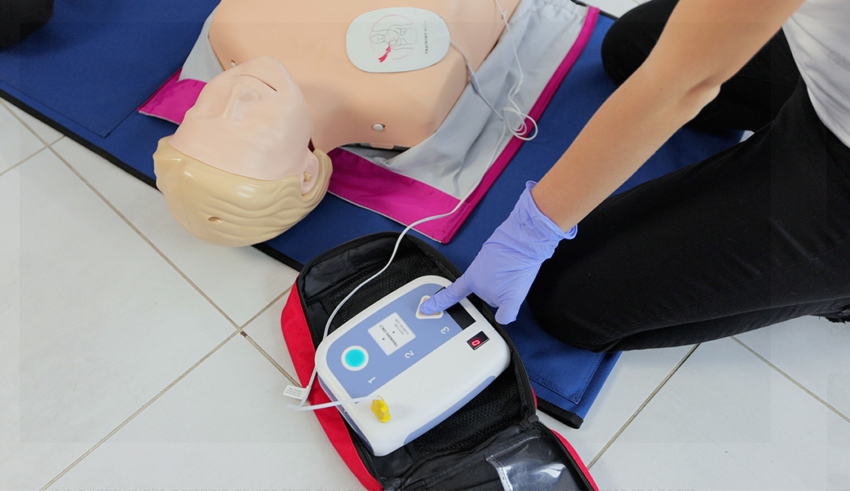
Part of being organized in the home is making sure you’re prepared in case of an emergency. That is why it’s important to have easy access to an AED. An automated external defibrillator (AED) is a transportable electronic device. The equipment aids you in saving a loved one or friend in case their heart stops or they stop breathing.
Therefore, this piece of equipment is useful for reviving and saving the life of someone who suffers sudden cardiac arrest (SCA). However, don’t confuse an SCA with a heart attack. The two medical events are not the same thing.
An SCA is triggered when an electrical disturbance affects the heart. The main symptoms are unresponsiveness and loss of consciousness. Immediate use of a defibrillator or CPR is required, as either life-saving measure increases the rate of survival until emergency help arrives.
Defibrillation is therefore the application of an electric shock to restore the heart’s normal rhythm and respiration. For example, if someone is a drowning victim, an AED can restore breathing and is a valuable device to have.
Table of Contents
Best Locations for AED Placements
Some of the best places to install an AED include:
- Near entrances to the home like the front door or patio entry. This allows for fast access in the event of an emergency and saves time rushing to retrieve the AED from a more remote area of the house.
- Inside a bedroom where an elderly person or infirm loved one sleeps.
- Centralized locations on each floor, such as hallways, stair landings or foyers.Make sure a device can be accessed from anywhere in the house..
- Exercise rooms or recreational areas. For those who use in-home exercise equipment like treadmills, ellipticals or exercise bikes, having an AED nearby is ideal. Strenuous activity may elevate the risk of cardiac distress.
- Near staircases. Installing an AED at the top and bottom of a staircase in a multi-level home reduces the time required to retrieve the machine, especially if responding to an emergency on another floor. Every second counts during cardiac arrest.
- Just inside a patio door, close to a pool in a dry area. AEDs work best when they’re not exposed to moisture.
Again, an AED in an optimal home location, along with proper CPR training, can mean the difference between life and death during a cardiac emergency, or while waiting for emergency responders to arrive.
Choosing high-visibility, easily accessible areas in a home and educating all family members on the locations and the use of the AED is critical. Make sure you place the device in places that are not subject to temperature extremes or excess humidity, such as a bathroom, attic, or garage.
An AED should be installed in a dry space where the temperature ranges from 32 degrees Fahrenheit to 122 degrees Fahrenheit.
Within Easy Reach of All
Place the AED in a spot that can be easily accessed by people of all abilities. For multi-level homes, consider installing additional AED units on separate floors in quick reach for faster emergency response times.
Installing Your Home AED Properly
Once you have purchased an AED for your home, properly installing the device is crucial to ensuring it will function as intended in an emergency. The following steps will guide you through optimal placement and a more in-depth setup of your home AED.
Choose a Central, Visible Location
Again, select a spot for your AED that is out in the open, where it’s easily seen, and centrally located in your home. Hallways, landings, or entryways near living areas or the kitchen are ideal. Mount the AED unit on a wall about 5 feet from the floor so it is visible and within easy access for people of varying heights.
Consider Temperature Requirements
As noted, most AEDs operate from between 32 degrees Fahrenheit and 122 degrees Fahrenheit. Ideally, place the AED in a climate-controlled area of your house.
Allow Clear Access
The location you choose should allow unobstructed access to the AED, with a minimum of 3 to 5 feet of clearance in front of the unit. Do not install the unit behind furniture, decorations or other items that could block it from view or make it difficult to retrieve when precious seconds count..
Follow Instructions for Wall Mounting
Carefully follow the included instructions for proper wall mounting of your specific AED device. Mark the wall at the appropriate height, drill pilot holes, and secure a mounting bracket to wall studs or drywall anchors rated to support the weight.
Complete Registration and Setup
Once mounted, turn on your AED to complete the initial setup and registration as directed in the product instructions. This typically involves activating the battery, setting the clock, and registering the device with the manufacturer to activate the warranty. Your home AED is now installed and ready to save a life in an emergency.
Write down and share the serial number and device information to register the equipment with your local emergency response system.
Check Expiration Dates
The pads/electrodes and battery both have limited lifespans and expiration dates. Replace the pads every 2-4 years as indicated, and the battery every 4 years. Outdated parts can impact the performance and reliability of the AED.
Perform Regular Checks
On a monthly basis, inspect your AED to ensure it is functioning properly and ready for emergency use. Check the status indicator – making sure that the device is on and functioning.
Also, make sure no damage has occurred to the pads or cables. Press the power button to confirm the device activates properly. Refer to your device’s manual for any specific test procedures that the manufacturer recommends.
Consider a Service Contract
For maximum preparedness, consider enrolling in a service contract with the AED manufacturer or a third-party service provider. They can perform detailed inspections, software updates, and component replacements to keep your device in maximum working order.
Make sure you always stay on schedule with the required maintenance for the machine, including part replacements.
Get Onsite CPR and AED Training
Your family members, who may need to access and operate the AED, should complete CPR and AED training. While AEDs are designed to be used by untrained rescuers in an emergency, Basic Life Support (BLS) CPR training provides the skills and confidence needed to respond quickly and properly during a cardiac event.
Conclusion
You now have a better understanding of how to locate and install an AED in your home. By placing these life-saving devices in highly visible, central areas, or places that have heavier foot traffic, you’ll make your home more safe and secure. While no location is perfect, prioritizing access and visibility gives a person in need the best chance for survival.
In-Pulse CPR is a major provider of AED equipment. Use it as your go-to source for AED devices and CPR training.
(This article was written by Donna Ryan. If you have any comments or questions, you can reach her at donnar668@gmail.com.)














